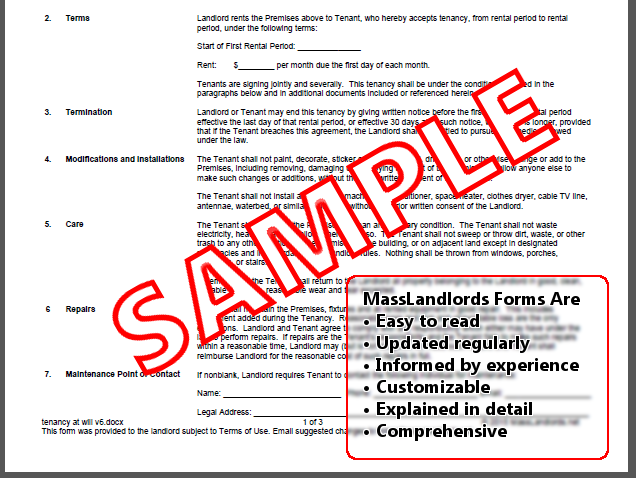Now Updated: MassLandlords Notice to Quit Forms
The MassLandlords members’ notice to quit forms page got an overhaul in early 2024, with newly worded forms for different tenancy situations available to all members. We will continue to provide member-edited notices, but we no longer recommend you use these unless you are highly confident they suit your purpose. An improper notice will derail an eviction. An attorney should now be considered required to serve a notice that will stick.

Serving a notice to quit for any reason is a legally complex endeavor. Make sure you know all the laws and consult with an attorney before moving forward. (License: 123rf)
Though the state has requirements for issuing a notice to quit, including mandated verbiage, the court has never issued a standard notice to quit for landlords. Doing so would require a change in the law. Instead, most attorneys use legal forms from the Massachusetts Continuing Legal Education group, or create a custom variant from them. They do this because each court has its own customs, and each case will have its own needs.
This revamp includes new 7- 14- and 30-day notices to quit, as well as notices for nonpayment and 30-day "no cause stated" notices. Our notices include precise legal language to keep you in compliance with our state’s ever-changing rental housing landscape. This article will discuss some of the most prominent changes you’ll find as you peruse the new forms.
Remember that any time you post a notice to quit for nonpayment to your tenants, you must also provide them with the state-issued notice to quit attestation form. This is a legal requirement. Not doing so will invalidate your notice to quit.
We provide these forms for informational purposes, but also strongly recommend you speak with an attorney before issuing any notices.
Hire an Attorney
We provide this DIY notice to quit page primarily for educational purposes. Serving your own notice to quit has become an expert maneuver since the pandemic. The federal CARES Act and state pandemic laws have permanently complicated what was once a simple thing.
A notice to quit is also a high-stakes action. At any point in subsequent court process, even a year into your eviction case, a renter can claim the notice to quit was defective. This could end your case.
Best practice is to hire an attorney before serving a notice. Although it costs money, and you are already in a position of having lost time and/or money, only an attorney who practices in the court where you will be filing can know exactly what type of notice or specific wording is most likely to stick.
Read this page so that you can supervise your attorney. Attorneys are busy and only human. There may be something here that you will want to remind them of. Together you can serve an effective notice to quit.
Negotiate in Parallel
The Nine Notice to Quit Forms Available
On our page, you’ll find the following forms:
- Standard, non-binding non-renewal letter
- 7-day notice to quit for cause
- Covered property 30-day notice for nonpayment (lease)
- Covered property 30-day notice for nonpayment (at will)
- Non-covered property 14-day notice for nonpayment (lease)
- Non-covered property 14-day notice for nonpayment (at will)
- 30-day or rental period "no cause stated" notice (at will)
- 30-day or rental period "no cause stated" with offer to create new tenancy (at will)
- 72-hour notice for staying past lease term.
The standard non-renewal of lease letter is not a formal notice to quit. It is also non-binding, and is not mandatory. Use it as a potential way to motivate your renter to start looking for a new place, by giving them notice that you will not be renewing their lease when it expires.
The 7-day notice to quit for cause may be used for both leases and tenancy at will situations.
Note that only some judges require the 72-hour notice to quit for a tenant staying past lease term. We recommend everyone contact an attorney before serving any notice.
1. Standard, Non-binding Non-renewal Letter
- v9.1
- First published version.
To view this form, you must be logged-in and a member in good standing

MassLandlords is a nonprofit dedicated to helping owners rent their property. We try our best, but we can't guarantee these forms will always work. We provide legal information but never advice particular to your situation. Nothing on this site is meant to create an attorney-client relationship. We advise you consult with an attorney.
Why Are There So Many Legal Terms in a Massachusetts Notice to Quit?
MassLandlords strives to use plain language in all our renter-facing forms. Seeing so much legalese in notices to quit, which are quite prescriptive, will seem jarring compared to our lease, which uses plain language. It’s not a change we were looking forward to making, but since the Covid-19 pandemic, the purpose of a notice to quit has changed. It is now less about managing a relationship with a renter and more about navigating a minefield of court processes.
For this reason, we have tried our best to make sure that our forms’ language follows language used by notices that have worked in the past. You will see phrases that won't be readable for a lay person. “Quit and deliver up” means “get out and give me the keys,” but that plain English wording seems to lack legal power. “The day the answer is due” depends on the latest law and court standing order, but it's a specific deadline and we can't legally give any other deadline. “For use and occupancy only” means “I'll take your money for your debt reduction, but I refuse to start a new tenancy on a different payment schedule.” Judges are both textualist, expecting to see specific wording, and also wield equity powers, making it up as they go. We recommend you run anything by your own attorney before proceeding.
Consumer Financial Protection Bureau Language Removed from Notices
During the Covid-19 pandemic, new regulations on debt collection were put in place by the Consumer Financial Protection Bureau (CFPB). Regulation 1006.9 was enacted May 21, 2021, detailing the new rules. As a result, our notices to quit for nonpayment previously included the following language:
“Because of the global Covid-19 pandemic, you may be eligible for temporary protection from eviction under the laws of your state, territory, locality or tribal area, or under Federal Law. Learn the steps you can take now: visit www.cfpb.gov/eviction or call a housing counselor at 800-569-4287.”
However, 1006.9 is no longer the current regulation, according to the CFPB. The current regulations were put in place in April 2023, and 12 CFR Part 1006 no longer has 1006.9 listed. This is not surprising; the Covid-19 regulations were always meant to expire. A footnote in the original regulations enacting 12 CFR Part 1006.9 states, “In the event the CDC further extends the CDC Order, the Bureau expects that the requirements and prohibitions in this interim final rule will continue to apply until the expiration of any such extension.”
Therefore, we have removed the CFPB-specific language from our notices going forward.
Why Isn’t There Any Debt Collection Verbiage on These Forms?
You’ll notice that our notices to quit do not include language on debt collection practices. There are some instances where such notice might be appropriate, but most mom-and-pop landlords would not be considered debt collectors.
We write for an audience primarily of lessors, but if you were a third party management company or attorney under limited assistance representation, it might be best to include certain notices of fair debt collection practices under 15 USC 1692. We do not include these. The definitions of “debt collector” in 1692A excludes people collecting for their own account:
“The term ‘debt collector’ means any person who uses any instrumentality of interstate commerce or the mails in any business the principal purpose of which is the collection of any debts, or who regularly collects or attempts to collect, directly or indirectly, debts owed or due or asserted to be owed or due another.”
As rental operators our principal purpose is not the collection of debts. Nor are we issuing notices for another. The primary definition therefore does not apply. Furthermore, lessors are exempted:
“The term does not include…any person collecting or attempting to collect any debt owed or due or asserted to be owed or due another to the extent such activity...concerns a debt which was originated by such person[.]”
As we originated the debt as a lessor, we are not a third-party “debt collector.” Our notices therefore do not include debt collection disclosures. An attorney's or manager's notices may.

As court processes get longer and less certain in for-cause eviction hearings, many landlords are opting to pursue "no cause stated" evictions instead. Image: Springfield Housing Court, public domain.
Three Types of Evictions: Cause, Nonpayment, and "No Cause Stated"
There are three types of evictions, or general reasons for evicting a tenant. They are: 1) cause, 2) nonpayment and 3) "no cause stated."
Cause
An eviction for cause is a legal action taken by you against a tenant or tenants who have breached the rental agreement. Examples of for-cause evictions may include smoking in a rental unit when there’s a no-smoking clause in the rental agreement; harassing or threatening fellow tenants when the rental agreement says not to; acquiring a pet in a rental with a no-pet clause; or criminal activity conducted on or in the rental property when the rental agreement says not to. These are just a few examples; there are many other possible causes for initiating eviction. Some landlords have leases that define repeated nonpayment as a cause. You must use a good rental agreement that covers all possible causes.
2. 7-day notice to quit for cause
- v6.1
- Substantial overhaul to form and wording as part of 2024 spring cleanup.
- Add detailed list of causes.
- v5
- Overhauled for best practice.
- v2
- Removed language about consequences if notice is ignored.
- v1
- First published.
- Any version number that appears missing was for internal revisions only.
To view this form, you must be logged-in and a member in good standing

MassLandlords is a nonprofit dedicated to helping owners rent their property. We try our best, but we can't guarantee these forms will always work. We provide legal information but never advice particular to your situation. Nothing on this site is meant to create an attorney-client relationship. We advise you consult with an attorney.
Nonpayment
An eviction for nonpayment is simply a court procedure to remove a tenant who has not paid or is not paying rent. This eviction action is different for a tenant under a lease than for a tenant at will (see below).
"No Cause Stated"
A "no cause stated" eviction is a legal action to remove a tenant from a rental without having to prove a reason. This is simply a method for the property owner (landlord) to repossess the rental property for any reason. A "no cause stated" eviction can be legally applied for a tenant at will. A lease holdover would receive the lease holdover notice.
Many mistakenly believe "no cause stated" evictions are used only when landlords want to sell a property, renovate it or live in it. Many including court staff even incorrectly call such an eviction "no fault." That phrase is not in the law. Yes, sometimes landlords issue an eviction notice when a renter seems to be not at fault, but it's expensive and risky for the landlord. There are half a dozen alternatives to eviction that preferentially get used in these scenarios. As court durations increase, and the likelihood of a "no cause stated" eviction succeeding in court decreases, "no cause stated" evictions are increasingly reserved for cases where the landlord has a for-cause case but cannot meet the threshold of evidence to succeed in court. For example, a landlord may have evidence against one tenant from another renter, but that renter will not testify in court for fear of retaliation. Or, consider the for-cause case of Gwendolyn Property Management v. Goodwin and Johnson. The landlord and other tenants knew the renters in question were smoking in violation of the lease. But the judge threw out the case as hearsay, claiming no one could know the difference between cigarette smoking and vaping. A "no cause stated" case got the renters out.
Leased Tenant vs. Tenant at Will: Options to Cure Notice to Quit for Nonpayment
A notice to quit may be legally served to a tenant not paying rent under either a lease (long- or short-term) situation or as a tenant at will. However, there is a difference between the tenants’ right to cure the nonpayment and protect their tenancy.
A leased tenant who is served a notice to quit for nonpayment has the option to “cure” their nonpayment violation. At any point, the leased tenant may cure the violation by paying all rent owed, plus interest and landlords’ court costs on or before the date that their court answer is due. A leased tenant can cure an unlimited number of notices.
Tenants at will are also allowed to cure nonpayment violations. A renter gets one do-over per 12 months in Massachusetts, where they may stop the eviction process by paying owed rent within 10 days of receiving the notice. If explanation of the opportunity to cure is not included with the notice to quit, then the tenant at will may still cure their delinquent tenancy within 10 days of the notice.
3. Covered property 30-day notice for nonpayment (lease)
- v5.1
- Substantial overhaul to form and wording as part of 2024 spring cleanup.
- More forcefully worded.
- Note: We used to have a dual-purpose 30-day notice to quit. Revision notes for that form are not shown here.
To view this form, you must be logged-in and a member in good standing

MassLandlords is a nonprofit dedicated to helping owners rent their property. We try our best, but we can't guarantee these forms will always work. We provide legal information but never advice particular to your situation. Nothing on this site is meant to create an attorney-client relationship. We advise you consult with an attorney.
4. Covered property 30-day notice for nonpayment (at will)
- v5.1
- Substantial overhaul to form and wording as part of 2024 spring cleanup.
- More forcefully worded
- Note: We used to have a dual-purpose 30-day notice to quit. Revision notes for that form are not shown here.
To view this form, you must be logged-in and a member in good standing

MassLandlords is a nonprofit dedicated to helping owners rent their property. We try our best, but we can't guarantee these forms will always work. We provide legal information but never advice particular to your situation. Nothing on this site is meant to create an attorney-client relationship. We advise you consult with an attorney.
5. Non-covered property 14-day notice for nonpayment (lease)
- v5.1
- Substantial overhaul to form and wording as part of 2024 spring cleanup.
- More forcefully worded.
- Removed pandemic CFPB language.
- Forked from 14-day notice used for lease or tenancy-at-will with customization.
- v4
- Added recommendation about eviction protection from the Consumer Financial Protection Bureau (CFPB).
- v2
- Removed language about consequences if notice is ignored.
- v1
- First published.
- Revisions that seem missing were for internal use only.
To view this form, you must be logged-in and a member in good standing

MassLandlords is a nonprofit dedicated to helping owners rent their property. We try our best, but we can't guarantee these forms will always work. We provide legal information but never advice particular to your situation. Nothing on this site is meant to create an attorney-client relationship. We advise you consult with an attorney.
6. Non-covered property 14-day notice for nonpayment (at will)
- v5.1
- Substantial overhaul to form and wording as part of 2024 spring cleanup.
- More forcefully worded.
- Removed pandemic CFPB language.
- Forked from 14-day notice used for lease or tenancy-at-will with customization.
- v4
- Added recommendation about eviction protection from the Consumer Financial Protection Bureau (CFPB).
- v2
- Removed language about consequences if notice is ignored.
- v1
- First published.
- Revisions that seem missing were for internal use only.
To view this form, you must be logged-in and a member in good standing

MassLandlords is a nonprofit dedicated to helping owners rent their property. We try our best, but we can't guarantee these forms will always work. We provide legal information but never advice particular to your situation. Nothing on this site is meant to create an attorney-client relationship. We advise you consult with an attorney.
What is a Covered vs. Non-covered Property?
You will notice forms on our site that are specifically for “covered properties.” Covered properties are rental units in which a tenant lives who is either receiving rental assistance through a voucher program, such as Section 8, or one in which the mortgage is backed by a loan from Fannie Mae or Freddie Mac. Covered properties were defined and protected as part of the federal CARES Act of 2020, a Covid-19 pandemic stimulus package.
Serving a notice to quit for such properties must be done 30 days in advance of the desired lease expiration. Even in the case of nonpayment, a tenant living in a covered dwelling must be allowed a 30-day notice to quit. While many CARES Act provisions have expired, the 30-day requirement for notice to quit for covered properties has no expiration date. For tenants in non-covered properties, Massachusetts law states a 14-day notice to quit may be served for nonpayment. The CARES Act preempts this for covered properties only.
You can find out if your rental is a covered property by using Freddie Mac or Fannie Mae lookup tools. If uncertain, check both.
Why are some notices “30 days or Rental Period”?
General Law Chapter 186 Section 12 requires that tenancies at will being terminated "no cause stated" receive the longer of two timeframes: either the interval at which rent is due or 30 days. Case law establishes that the day notice is served is “day zero,” and also, that a notice only takes effect on a rent due date. For a notice to quit in July, this means you will serve in May.
Suppose it's May 31 and you serve the notice that day. May 31 is “day zero.” June 1 is “day one.” Thirty days after notice is June 30. But rent would not be due again until July 1. Since the time between rental periods (June 1 to July 1) is longer than 30 days (it's 31 days), the tenancy ends July 1 (one full rental period after notice). This ends up being a “rental period notice.”
February is harder because the month is never 30 days long. Suppose it's January 31. If you serve notice that day, January 31 is “day zero.” February 1 is “day one.” Thirty days later in a non-leap year is March 2. You might expect the notice would take effect then, but case law says notice takes effect only on a rent due date. Your next rent due date is April 1. So this notice takes effect April 1. You can't go shorter because you didn’t give at least 30 days.
To serve a rental period notice effective March 1, you must serve on or before January 29 in a non-leap year. January 29 is “day zero.” January 30 is “day one.” Thirty days later is February 28. Your notice can take effect March 1.
7. 30-day or rental period "no cause stated" notice (at will)
- v5.1
- Substantial overhaul to form and wording as part of 2024 spring cleanup.
- More forcefully worded.
- Note: We used to have a dual-purpose 30-day notice to quit. Revision notes for that form are not shown here.
To view this form, you must be logged-in and a member in good standing

MassLandlords is a nonprofit dedicated to helping owners rent their property. We try our best, but we can't guarantee these forms will always work. We provide legal information but never advice particular to your situation. Nothing on this site is meant to create an attorney-client relationship. We advise you consult with an attorney.
8. 30-day or rental period "no cause stated" with offer to create new tenancy (at will)
- v5.2
- Substantial overhaul to form and wording as part of 2024 spring cleanup.
- More forcefully worded.
- Note: We used to have a dual-purpose 30-day notice to quit. Revision notes for that form are not shown here.
To view this form, you must be logged-in and a member in good standing

MassLandlords is a nonprofit dedicated to helping owners rent their property. We try our best, but we can't guarantee these forms will always work. We provide legal information but never advice particular to your situation. Nothing on this site is meant to create an attorney-client relationship. We advise you consult with an attorney.
How to Deliver a Notice to Quit
Once you've filled out the form, you must serve the notice to the tenant. You can attempt to do this in a couple ways:
- Hand-deliver it.
- Hire a constable to hand deliver it.
- Mail it.
- Tape it to the door.
You must prove that the tenant actually received the notice. For this reason, you cannot tape a notice to a door in Massachusetts (no proof of receipt).
You can attempt to mail it, but if the tenant knew what was good for them, they would say they never got it. Even if you require a signature, the savvy tenant can refuse to sign for it. Even if you send it certified, that’s only proof of mailing and not proof of lawful delivery.
The only option we can recommend that will work statewide, any court, any judge, almost all the time is delivery by a constable or sheriff (typically around $50). These two specific roles have a special power: any notice delivered by them, even if taped to a door, is presumed delivered.
If you are hand-delivering something uncontested yourself (e.g., a friendly notice to quit), we suggest you get your tenant's signature at delivery.
All notices to quit for nonpayment must be accompanied by the EOHED rights sheet available and updated regularly at Mass.Gov/NoticeToQuit. Failure to serve this right's sheet will prevent filing in court. This has been the case since January 1, 2021. This was made permanent by Chapter 107 of the Acts of 2022. The notice on the EOHED site about not needing to file this form after April 1, 2023 is about filing with EOHED only. You still must serve the form to the renter with your notice.
Frequently Asked Questions
Here are the most common questions we get at MassLandlords about issuing notices to quit. Remember, your attorney is your best source of guidance for your individual situation.
Should I issue multiple notices to quit for the same situation?
No. Do not do this. If you issue multiple notices to quit, the judge will have to determine which set of case law they want to follow. Pick one notice, issue it and stand behind it.
Suppose you issue one 30-day notice that you think was ignored, so you issue a second one. Well, the tenant might have seen both and can ask to have the later one reset the clock. The same goes if you issue a 14-day and a 30-day. The judge might decide to disallow the 14-day notice and go with 30 days. Or, if the judge thinks you were trying to deceive the tenant out of their right to proper notice, the judge might decide to disallow both notices.
Attorneys familiar with different courts can advise you about your specific jurisdiction.
What if my tenant neither pays nor quits after receiving notice?
If the tenant ignores your notice and continues to occupy the premises after the date given on the notice, you will have to seek to enforce the notice by filing for eviction in court.
Make sure to count whole days. The day after the day you give notice is day one, not day two.
What if I need to serve notice, but rent is not due on a monthly basis?
If you have a non-standard rental period, you’ll probably need an attorney, and you’ll need to proceed carefully. The law allows for monthly rent, but you may trigger a requirement to give 90 days' notice for some rent schedules.
My Tenant Says They’re Not Leaving when the Lease Ends. Now what?
That’s unfortunate, but there is one final notice for this situation.
9. 72-hour notice for staying past lease term.
- v2.1
- First published.
To view this form, you must be logged-in and a member in good standing

MassLandlords is a nonprofit dedicated to helping owners rent their property. We try our best, but we can't guarantee these forms will always work. We provide legal information but never advice particular to your situation. Nothing on this site is meant to create an attorney-client relationship. We advise you consult with an attorney.
In Summary
Ideally, your evictions will be few and far between. It’s always better to find solutions that work for you and your current tenant than spending thousands of dollars and months in court pursuing eviction. However, we understand that sometimes terminating a tenancy (for non-payment or any other reason) is inevitable. If you must issue your renters a notice to quit, our newly updated forms will start you off on the right foot. And don’t forget that required attestation form.




